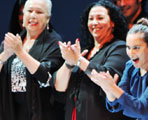Sunday, September 30th, 2012. 2030h. Teatro de la Maestranza
Special 17 Bienal de Flamenco de Sevilla – All the information
Text: Estela Zatania
Photos: La Bienal
Once upon a time there was flamenco in Seville
Guest artists: Merche Esmeralda, José Galván. Soloists: Rafaela Carrasco, Belén Maya, Pastora Galván, Farruquito, Rafael Campallo. Flamenco group: Manuela Ríos, Hiniesta Cortés, Isabel López, Yolanda Heredia.
Dancers: Adela Campallo, Pilar Ortega, Miriam Conde, Beatriz Santiago, Julia Acosta, Manuel Betanzos, Marcos Vargas, Ángel Atienza, Francisco Mesa “Nano”, José Luis Vidal “Lebri”, Alejandro Rodríguez, Raúl Gómez, Juan Aguirre. Guitar: Ramón Amador, José Luis Silva “Morito”, José Antonio Suárez “Cano”, Rafael Rodríguez, Jesús Torres. Voice: Miguel Ortega, Moi de Moron, Antonio Campos, Antonio Zúñiga. Director: Rafaela Carrasco.
Thus it began, and thus ended the seventeenth Bienal de Flamenco de Sevilla, with two different Carrascos, separated not only by a generation, but by stylistic light-years. Every day we hear how classic flamenco is outdated, no longer relevant, and we have to seek other paths. But for the closing of the Bienal, two opposing perspectives joined hands for the feely-goody closing “De la Punta a la Raíz”, (roughly translated, ‘from tip to tail’), leaving no doubt that flamenco still has a lot to say. This time there were no singers suspended from the ceiling, no filmy diaphanous fabrics, no surrealistic sets. And all those savings translated into the singing, dancing and guitar-playing of more than thirty top artists in an unforgettable unrepeatable extravaganza to pay tribute to the flamenco dancers of Seville, past and present.
The unlikely person commissioned to carry out this major project was dancer Rafaela Carrasco, an interpreter who follows the most avant-garde paths. In fact, I wasn’t expecting much from this gala event, but it turned out to be quite a treat. It was a show that was straightforward in concept and execution, with clean honest staging and well-prepared artists.
Seven different scenes were devoted to a relevant figure or facet of Seville flamenco dance. A group number represented the contemporary vision of Mario Maya, with some of his most outstanding students, notably his daughter Belén who recalled her father’s geometric forms dancing seated as he used to do. The segment devoted to José Galván was another generational celebration. The father of Israel and Pastora danced soleá to the singing of Antonio Campos, Moi de Morón and Miguel Ortega under the watchful eye of Pastora who then took up the virtual gauntlet to continue the dance. Juan Antonio Suárez “Cano” and Jesús Torres provided the guitar accompaniment.
With the same singers and guitarists, the scene devoted to Manolo Marín highlighted Rafael Campallo, Marín’s most successful student, and images of Marín and his disciple were projected during the tangos.that were danced. Matilde Coral’s vignette was also enhanced with audiovisual material in which Matilde explained details of the so-called “escuela sevillana”, which she herself cultivated and taught students such as Rafaela Carrasco herself, who on this occasion put aside her avant-garde instincts to dance classic alegrías with bata de cola, although she didn’t quite seem at home in the part.
The scene honoring Farruco couldn’t go wrong with Farruquito’s soleá, and the grandson toned down his own energy to emulate forms more reminiscent of his grandfather, with veteran guitarist Ramón Amador, in addition to Antonio Zúñiga and Moi de Morón singing. We were able to see a fragment of the film “Flamenco” in which grandfather Farruco symbolically passed the torch onto young Farruquito.
A moving scene devoted to Adelita Domingo was sung and danced by Merche Esmeralda looking quite beautiful, to honor her legendary teacher who died less than two months ago.
The last vignette offered a typical flamenco cuadro with Amador on guitar, in addition to Rafael Rodríguez and José Luis Silva “Morito”, with surprisingly high quality in the dancing, particularly by Hiniesta Cortés and Yolanda Heredia.
The fiesta finale was yet to come, the mother of all bulerías endings, and no one seemed to feel limited by the classic forms when they joined the people already on stage, artists like Manuela Carrasco, Cristina Hoyos, Javier Barón, Matilde Coral, Carmen Ledesma, Ana María Bueno….”a cast of thousands”, and it was moving to watch them jump up out of the audience, one, and then another, and another…eloquent testimony in this Bienal devoted to dance, to Seville’s tremendous contribution to the artform.
For one magical night, the younger generation put aside its hunger for novelty and made peace with tradition, director Rosalía Gómez showed what can be done with a limited budget and the world cultural heritage known as “flamenco” was on display in all its glory to wind up this edition of the Bienal de Flamenco de Sevilla.
